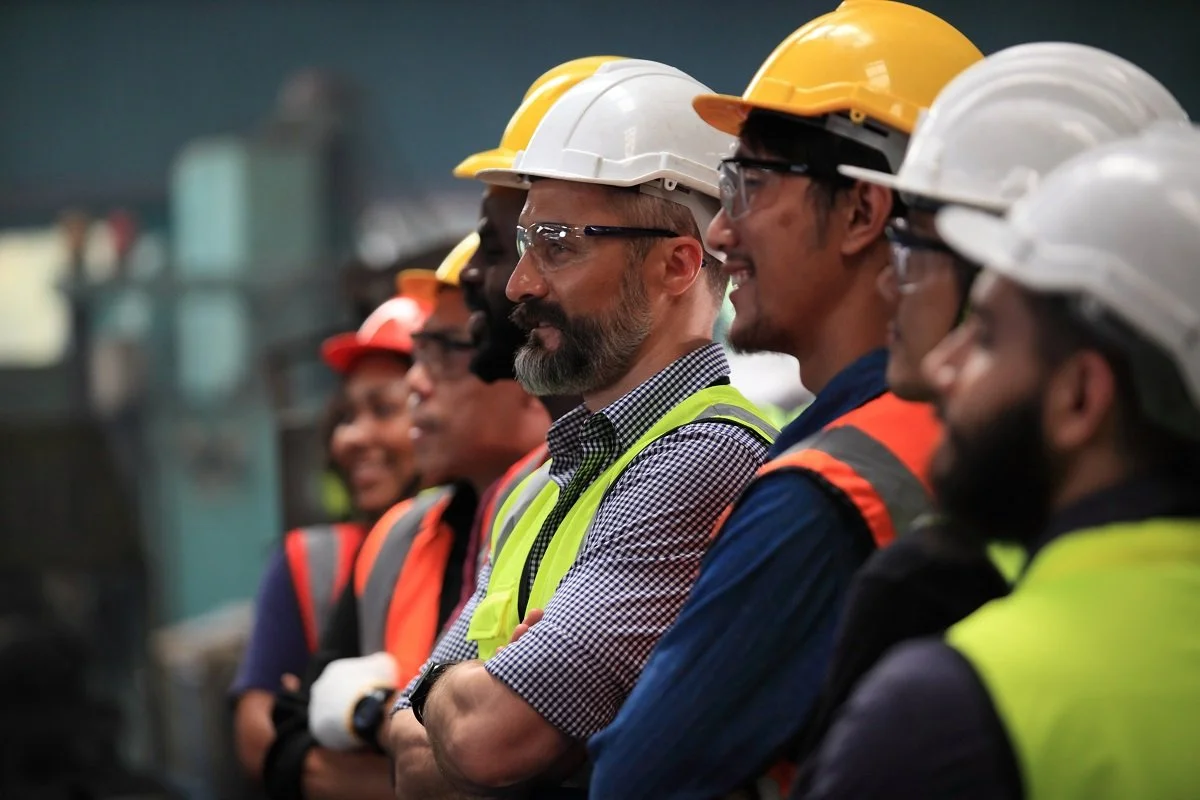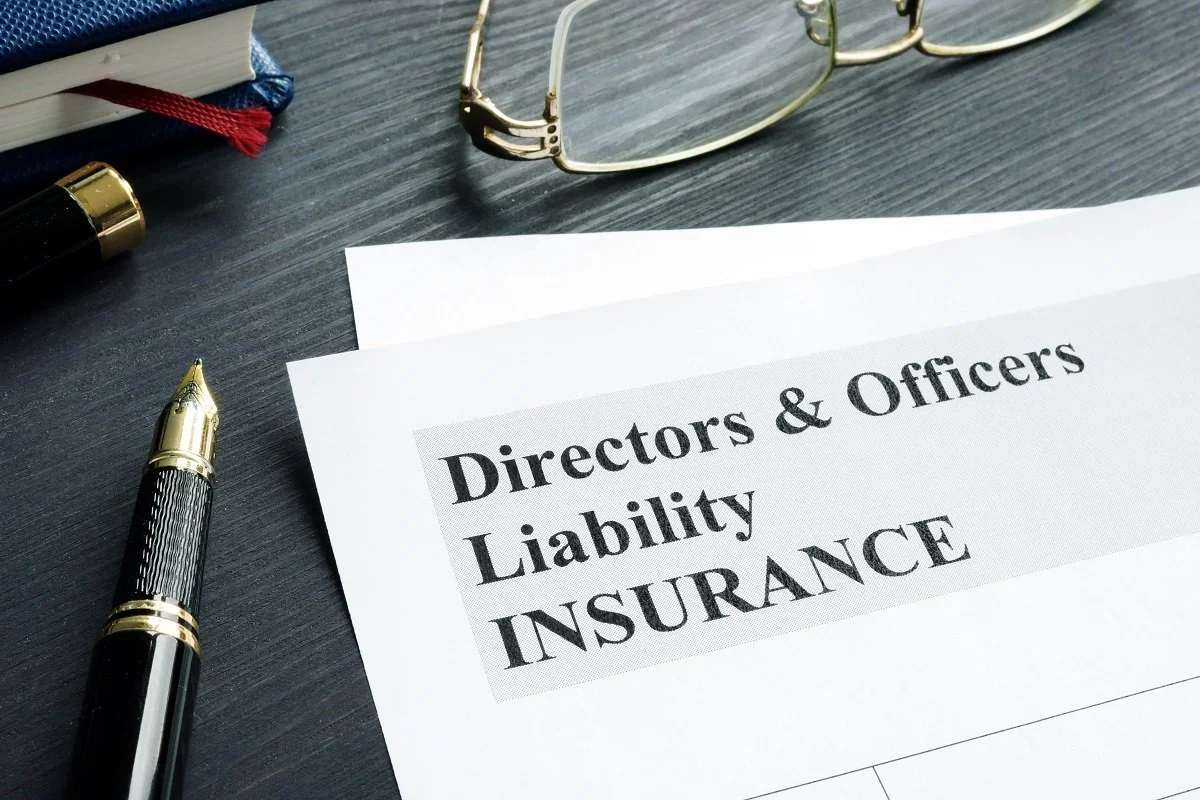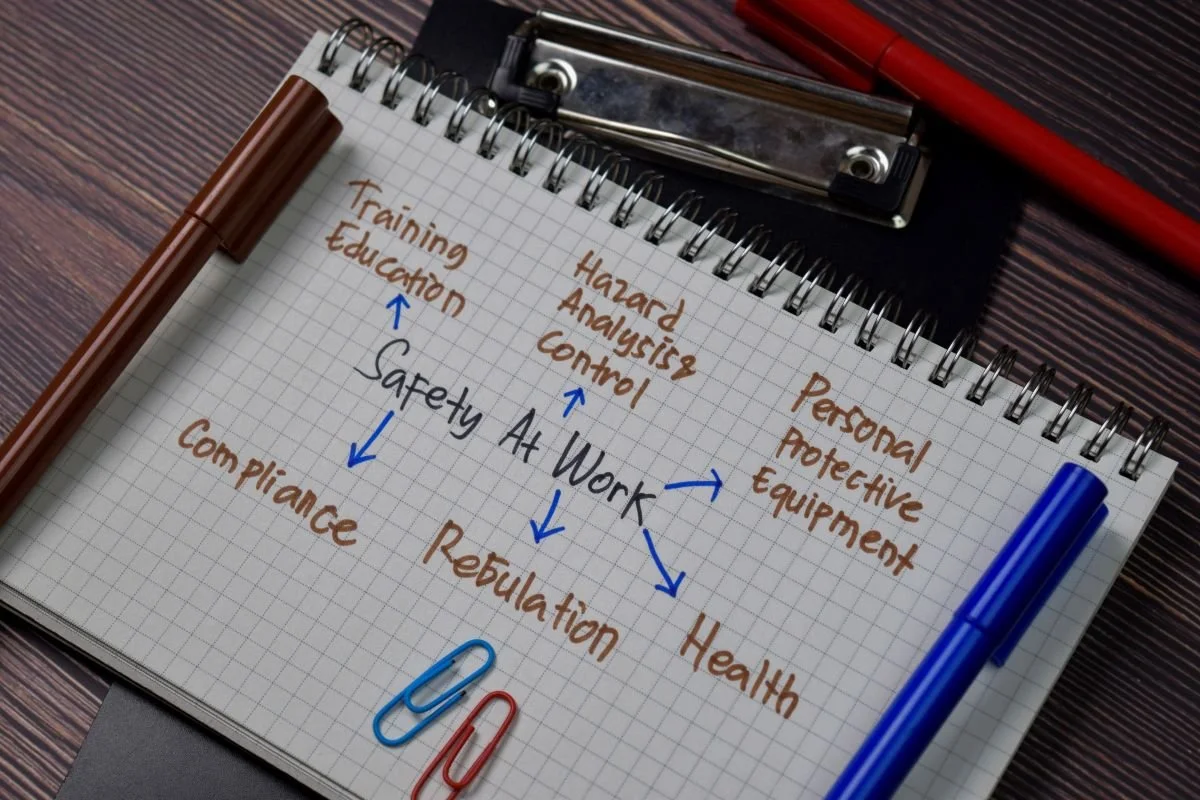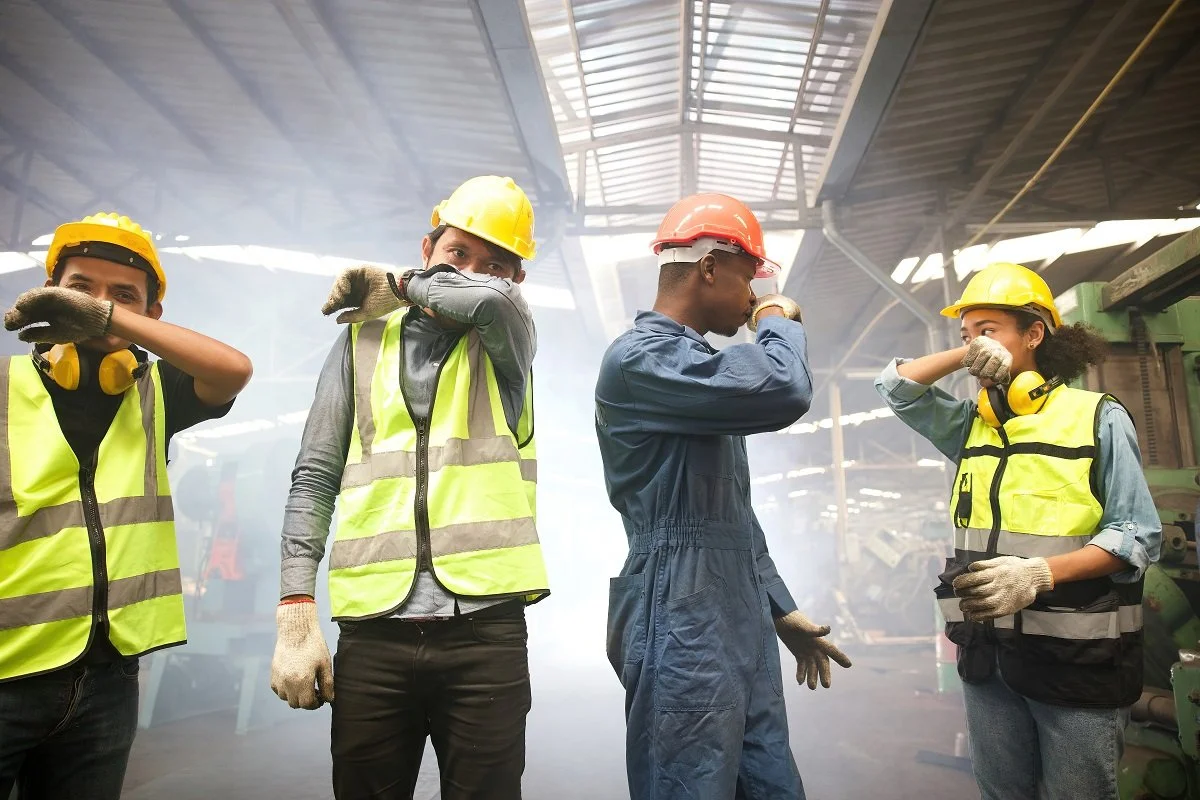
Industry News

Breaking Down the First Few Components of the IIPP
Author, Jack Marrs, Associate Account Executive, Rancho Mesa Insurance Services, Inc.
Building upon Sam Brown’s article “Guidance for Developing an Effective Injury and Illness Prevention Program” (IIPP), I would like to delve further into some of the key components of an IIPP. In this first installment, I will explore assigning the right person to create the IIPP, compliance with safety regulations, and effective communication.
Author, Jack Marrs, Associate Account Executive, Rancho Mesa Insurance Services, Inc.
Building upon Sam Brown’s article “Guidance for Developing an Effective Injury and Illness Prevention Program” (IIPP), I would like to delve further into some of the key components of an IIPP. In this first installment, I will explore assigning the right person to create the IIPP, compliance with safety regulations, and effective communication.
Person Responsible for Creating the IIPP
This person must understand the ins and outs of the organization. They must be familiar with the workplace hazards and understand what safety measures need to be put in place. They are also in charge of updating the program and improving it as the organization changes and grows. This individual must also be formally mentioned in the IIPP, clarifying the assigned responsibility for overseeing this aspect of safety by including their name in the document.
Compliance with Safety Regulations
The IIPP outlines the system for ensuring employees comply with safe and healthy work practices.
This entails effectively training and informing employees about their responsibilities and expectations. Employees need to understand the system that is put in place as well as the safety procedures and the requirements of the IIPP. Providing positive recognition and rewarding employees who are following the IIPP guidelines is crucial, while disciplinary measures should be put in place for those who fail to comply. This is how you begin to create a culture of safety and accountability. Also, to ensure your IIPP stays up to date, it is considered best practices to regularly review and update all rules and procedures as needed.
Effective Communication
The IIPP must include a system for communicating with employees in a form readily understandable by all affected.
It remains critical to effectively communicate with your employees on matters that relate to the IIPP. Clear communications can be learned through trainings. And, it is important that employees use language that can be easily interpreted. According to the State Fund, “your communication system should include provisions for encouraging employees to report potential hazards in the work environment without fear of reprisal. One way to do this is to have a notification system where employees report hazards anonymously.” This helps eliminate fear in the employee and allows them to feel comfortable holding their co-workers to the IIPP standard. Effective communication can help prevent injuries from happening in the first place.
By embracing these components, organizations can create a culture of safety and accountability.
The next IIPP article will cover the three critical components of the IIPP: identifying work place hazards, investigating occupational injury or illness, and work practices/procedures.
If you have any inquiries, feel free to reach out to me at (619) 486-6569 or via email at jmarrs@ranchomesa.com.
Heat Illness Awareness Vital for California's Construction Companies
Author, Kevin Howard, Account Executive, Rancho Mesa Insurance Services, Inc.
California faces a critical need to prioritize heat illness awareness among its workforce. The combination of Southern California's recent above average rainfall and the anticipated heatwave resulting from El Niño has created the possibility of an extremely warm summer. Construction companies must remain vigilant and adaptable, implementing appropriate measures to address these changing weather dynamics and ensuring the safety of their workers. By staying informed about weather forecasts and implementing flexible work schedules and site preparations, companies can effectively navigate these challenging conditions and prioritize the well-being of their employees. By understanding the significance of heat illness awareness, companies can ensure the safety and well-being of their workers while fostering productivity, minimizing downtime, and improving overall project efficiency.
Author, Kevin Howard, Account Executive, Rancho Mesa Insurance Services, Inc.
California faces a critical need to prioritize heat illness awareness among its workforce. The combination of Southern California's recent above-average rainfall and the anticipated heatwave resulting from El Niño has created the possibility of an extremely warm summer. Construction companies must remain vigilant and adaptable, implementing appropriate measures to address these changing weather dynamics and ensuring the safety of their workers. By staying informed about weather forecasts and implementing flexible work schedules and site preparations, companies can effectively navigate these challenging conditions and prioritize the well-being of their employees. By understanding the significance of heat illness awareness, companies can ensure the safety and well-being of their workers while fostering productivity, minimizing downtime, and improving overall project efficiency.
Recognizing the Risks
The construction industry in California is particularly vulnerable to heat-related illnesses and fatalities due to the physically demanding nature of the work and prolonged exposure to high temperatures. Heat stress, heat exhaustion, and heat stroke are severe conditions that can result in significant health complications. By acknowledging the risks associated with working in high temperatures, construction companies can proactively take measures to mitigate potential hazards.
Cultivating a Culture of Safety
Establishing a culture of safety is crucial for construction companies in California to create an environment where employee well-being is the top priority. Employers should develop comprehensive programs focused on preventing heat-related illnesses. These initiatives should include employee training, hazard assessments, access to shade and water, acclimatization procedures, and adjusted work schedules. Regular safety meetings and open lines of communication should be encouraged to address concerns, share information, and ensure that everyone is aware of the potential risks associated with working in high heat.
Implementing Worksite Modifications
Modifying the worksite environment can reduce the impact of heat-related illnesses. Construction companies should establish shaded rest areas where workers can take breaks, cool down, and hydrate. Access to potable water should be readily available to prevent dehydration, and regular hydration breaks should be scheduled throughout the day. Additionally, adjusting work schedules to avoid the hottest periods, utilizing cooling fans or misting systems, and implementing rotational job assignments can help reduce heat stress and improve worker safety.
Monitoring and Supervision
Supervisors and management play an important role in ensuring heat illness awareness on construction sites. Regular monitoring of weather conditions and temperature provides valuable information for determining appropriate work practices and scheduling. Close supervision enables the early detection of signs of heat-related illness and allows for immediate intervention. Encouraging workers to prioritize their own well-being and empowering them to report any symptoms promptly is equally important.
Heat illness awareness is vital for construction companies operating in California. By prioritizing worker safety and implementing comprehensive programs to prevent heat-related illnesses, employers can safeguard their employees from the risks associated with high temperatures. Moreover, such initiatives enhance productivity, avoid worker’s compensation claims, reduce downtime due to illness or injuries, and improve overall project efficiency. By cultivating a safety culture, providing necessary PPE, implementing worksite modifications, and maintaining close supervision, construction companies can establish a healthy and safe working environment that ensures the well-being of their workers.
Rancho Mesa’s Upcoming Heat Illness Prevention Workshop
Lastly, Rancho Mesa Insurance is hosting our annual Heat Illness Prevention workshop on June 2nd at the Mission Valley library from 10:00 AM to 11:30 AM. This workshop will provide valuable insights, best practices, and resources to help construction companies and their employees effectively address and prevent heat-related illnesses. Be sure to join this workshop to stay informed and proactive in ensuring the health and safety of your workforce.
Contractor Strategic Planning with Kevin Brown of RBTK, LLP
Author, Matt Gaynor, Director of Surety, Rancho Mesa Insurance Services, Inc.
In my recent StudioOne™ podcast episode with Kevin Brown, Of Counsel with the CPA Firm RBTK, LLP, we discuss the anatomy and considerations that go into strategic planning for your business.
Author, Matt Gaynor, Director of Surety, Rancho Mesa Insurance Services, Inc.
In my recent StudioOne™ podcast episode with Kevin Brown, Of Counsel with the CPA Firm RBTK, LLP, we discuss the anatomy and considerations that go into strategic planning for your business.
The podcast addresses questions, such as:
What do you want your business to accomplish?
What steps will help my company achieve its goal(s)?
The episode includes a discussion of the importance of developing a succession plan.
If you would like more information on Episode 309, please contact Kevin Brown at kbrown@rbtk-cpa.com.
Implementing Best Practices when Hiring in the Construction Industry
Author, Casey Craig, Account Executive, Rancho Mesa Insurance Services, Inc.
With unemployment rates settling near 4 percent, it is becoming increasingly difficult to find the right employees to help grow your construction company. With most able-bodied workers having secure employment, this leads to having either apprentice-type employees that come with unique challenges or pulling from an aging workforce that can bring cumulative injuries and risks. Navigating these issues can be complex and there is not a perfect solution, but employer’s hiring practices need to change in order to keep up with the current state of the industry.
Author, Casey Craig, Account Executive, Rancho Mesa Insurance Services, Inc.
With unemployment rates settling near 4%, it is becoming increasingly difficult to find the right employees to help grow your construction company. With most able-bodied workers having secure employment, this leads to having either apprentice-type employees that come with unique challenges or pulling from an aging workforce that can bring cumulative injuries and risks. Navigating these issues can be complex and there is not a perfect solution, but employer’s hiring practices need to change in order to keep up with the current state of the industry.
When hiring new employees, consider:
Pre-hire drug testing
Pre-hire physicals
Targeted job postings with accurate description of daily work
Multiple levels of interviews
Simulating work at your office that potential new hires would be performing in the field
The US saw a unique shift in the workplace as a result of COVID-19 where employees felt their value skyrocket as fewer people were willing to work in-person. Employers were forced to increase wages to get bodies on jobsites. In prior years, it may have been enough to just rely on word of mouth and referrals to get new hires. Too often now, we are seeing new hires suffer “ghost injuries” that are quickly followed with letters of representation. These and similar types of cumulative trauma claims can have long term impacts on your experience rating (EMR). While these situations are difficult to prevent, using best practices and conducting thorough interviews with your prospective employees will allow you to make educated decisions which typically lead to better hires.
Taking advantage of the best practices listed above can help insulate your company from poor hiring decisions. Obviously, we would love for new hires to turn into long term employees, as onboarding and proper training can be a costly expense in both other employee’s time and payroll. In a recent survey conducted by Traveler’s Insurance, it was shown that 34% of workplace injuries occurred during the worker’s first year on the job. This can be from a combination of inexperience, overexertion, and/or lack of safety knowledge.
Consider these hiring and onboarding processes to assist in mitigating the glaring number of claims that are emanating from newer employees or employees that have limited experience on jobsites. The financial impact they can have on your company will impact your balance sheet for years and can be potentially avoided with implementing some of our recommended techniques
To learn more about improving your hiring practices or how Rancho Mesa can help to improve your process, reach out at (619) 438-6900 or ccraig@ranchomesa.com.
Guidance for Developing an Effective Injury and Illness Prevention Program
Author, Sam Brown, Account Executive, Rancho Mesa Insurance Services, Inc.
As some company leaders may recall, since 1991, all California employers are required to maintain a written Injury and Illness Prevention Program (IIPP). An IIPP is an understandable and accessible safety program tailored to a business’ operations. An effective IIPP will help an employer establish and maintain a safe workplace while setting expectations and protocols for all employees.
Author, Sam Brown, Account Executive, Rancho Mesa Insurance Services, Inc.
As some company leaders may recall, since 1991, all California employers are required to maintain a written Injury and Illness Prevention Program (IIPP). An IIPP is an understandable and accessible safety program tailored to a business’ operations. An effective IIPP will help an employer establish and maintain a safe workplace while setting expectations and protocols for all employees.
The information below outlines the necessary elements of a written and effective IIPP, while recommending a resource to use when creating or updating the plan.
Cal/OSHA requires all Injury and Illness Prevention Programs to contain nine critical components:
A person (or persons) with authority and responsibility for implementing the program is identified.
A system for ensuring employees comply with safe and health work practices.
A system for communicating with employees in a form readily understandable by all affected.
Procedures for identifying and evaluating work place hazards.
Procedures to investigate occupational injury or illness.
Procedures for correcting unsafe or unhealthy conditions, work practices and procedures.
Provide employee training and instruction.
Procedures to allow employee access to the Program.
Recordkeeping and documentation.
California employers looking for guidance on the Cal/OSHA required Injury & Illness Prevention Program can often feel overwhelmed when addressing all required elements, while also abiding by the best practices of updating the plan, annually. Fortunately, California’s State Compensation Insurance Fund offers a free IIPP builder to all employers.
The State Fund’s IIPP Builder will help an employer create an IIPP from scratch, but can also help improve an existing program to make it more effective and compliant. An employer is first asked to answer a series of questions about safety practices. The answers will help build a safety program and tailor it to the business. The IIPP builder will also guide an employer through the required elements of the written IIPP.
Once finished, an employer can save the IIPP to their computer and upload it into their SafetyOne™ mobile app. They can also print and keep a hard copy at all locations. Lastly, to make it a truly effective program, the employers should share details of the IIPP with their employees.
Rancho Mesa wants clients to feel comfortable and confident when creating, updating, and sharing details of their Injury and Illness Prevention Program. To learn more about an effective IIPP and the State Fund’s IIPP BuilderSM, please contact me at sbrown@ranchomesa.com or (619) 937-0175.
Importance of Implementing a Stretch and Mobility Program
Author, Greg Garcia, Account Executive, Rancho Mesa Insurance Services, Inc.
When my baseball career ended in 2021, it was time for me to do something new with my life. For me the decision was easy and one that I am very grateful for. My dad, Dave Garcia started Rancho Mesa 25 years ago and throughout the years he and many others have contributed into what Rancho Mesa is today, a 16-time National Best Practices Agency. I was fortunate enough to get an opportunity to join such an amazing organization.
Author, Greg Garcia, Account Executive, Rancho Mesa Insurance Services, Inc.
Strains are one of the top workers’ compensation injuries affecting landscape companies. The Federal Bureau of Labor Statistics states that back strains account for almost 20% of all workers’ compensation injuries. When analyzing this data, we see there is a common theme - a lack of preventative measures to avoid back strains.
One of the reasons for the frequency of these back strain claims is due to the fact that employees are not properly stretching nor engaged before they perform their work for the day. With regards to safety, the top landscape companies have all implemented a stretch and mobility program of some kind.
Every day, there are two great opportunities to implement a stretch and mobility program. One of which would be at a morning huddle and the other would be at the jobsite. In either case, the most important take away is that there is a stretch program being implemented before the employees engage in any physical activity.
Knowing the importance of a stretch and mobility program for our clients, Rancho Mesa created the RM365 Advantage Mobility & Stretch™ Program for them to implement. We collaborated with a certified professional trainer to create a stretch and mobility program that is designed to help eliminate some of these injuries.
One version of the program can be completed at the morning huddle (without using a truck) and the other can be done at the jobsite (using a truck). Both versions are available in English and Spanish with pictures and descriptions of the movements that need to be performed.
Using Rancho Mesa’s SafetyOne™ mobile app, clients can document every day that they performed the RM365 Advantage Mobility & Stretch™ Program with a quick photo showing their employees in action.
By creating these simple programs and implementing it on a daily basis, we aim to lower the chances of our client’s employees being injured; thus, creating a safer work environment. In addition, limiting these types of claims will also help to lower the company’s experience MOD, which can also help create savings on workers’ compensation premiums.
For landscapers who currently do not have a stretch and mobility program, I would encourage them to reach out to their insurance advisor to help set one up. Or, take a look at the RM365 Advantage Mobility & Stretch™ Program on Rancho Mesa’s website.
Feel free to contact me with any questions about implementing a stretch and mobility program at ggarcia@ranchomesa.com or (619) 438-6905.
Maximize Your KPI Dashboard Insight
Author, Drew Garcia, Vice President of the Landscape Group, Rancho Mesa Insurance Services, Inc.
Three years ago, Rancho Mesa launched our proprietary safety KPI dashboard, consolidating experience mod and industry benchmarking reports to one working document. As a Rancho Mesa customer, you can now maximize the benefit of your safety KPI dashboard by completing our baseline training which will challenge the stakeholders in your organization to understand the key concepts this document delivers.
Author, Drew Garcia, Vice President of the Landscape Group, Rancho Mesa Insurance Services, Inc.
Three years ago, Rancho Mesa launched our proprietary safety KPI dashboard, consolidating experience mod and industry benchmarking reports to one working document. As a Rancho Mesa customer, you can now maximize the benefit of your safety KPI dashboard by completing our baseline training which will challenge the stakeholders in your organization to understand the key concepts this document delivers.
With the training and subsequent quiz behind you, you will be poised with the ability to roadmap your company’s commitment to safety and answer some common questions like:
Do all work-related injuries impact my XMOD the same?
What is an indemnity claim?
What is my estimated renewal XMOD?
How do we compare to our industry?
This training can also be used for employees who transition or are hired to help oversee your workers’ compensation program.
Quickly bring these employees up to speed by developing their skills through our online dashboard training.
Maximize your relationship with Rancho Mesa and train your team to better handle your workers’ compenasation program.
This course will be available in the SafetyOne™ platform in May 2023.
For more information, contact Drew Garcia at (619) 937-0200 or drewgracia@ranchomesa.com.
Signs of a Continued Hard Property Market in 2023
Author, Jeremy Hoolihan, Account Executive, Rancho Mesa Insurance Services, Inc.
The property insurance marketplace continues to be a challenging segment in 2023. With catastrophic events that have occurred over the last several years such as hurricanes, floods, wild fires, and major storms, the property marketplace has taken a huge hit that will take many years to recover. As a result, we expect property pricing to continue increasing for the foreseeable future. There are several real-world examples of the property market hardening.
Author, Jeremy Hoolihan, Account Executive, Rancho Mesa Insurance Services, Inc.
The property insurance marketplace continues to be a challenging segment in 2023. With catastrophic events that have occurred over the last several years such as hurricanes, floods, wild fires, and major storms, the property marketplace has taken a huge hit that will take many years to recover. As a result, we expect property pricing to continue increasing for the foreseeable future. There are several real-world examples of the property market hardening.
Insurance carriers are paying much more attention to the geographic diversity in their portfolios. In many cases, insurance companies are pulling out of areas of concern, such as wild fire or flood prone areas. More and more policyholders are receiving non-renewal notices as insurance carriers expand their hazard zones. This also has an adverse effect on those seeking property coverage because it limits the number of insurance carrier options.
Underwriters are also beginning to pay closer attention to the condition of the properties they currently insure or plan to insure. In the commercial property segment, loss control visits are becoming more frequent for buildings of all sizes. Loss control specialists will focus their attention on the state of the buildings, and the status of building updates such as electrical, plumbing, roofing, etc. More specifically, loss control specialists are even analyzing the age and brand of electrical panels. There is one brand of electrical panels called Zinsco that experts recommend replacing immediately due to fire hazard. Therefore, if a building is still equipped with a Zinsco panel, it is likely that these panels will need to be replaced before an insurance company will be comfortable providing terms and pricing.
Another sign of the deteriorating property market includes the recent announcement that California Insurance Commissioner Lara will increase the FAIR Plan coverage limit for commercial buildings from $8.4 million to $20 million. This is a direct result of insurance companies pulling out of areas that are deemed high hazard. This limits the number of insurance companies available to write property policies in these areas and in some cases there are no options at all. Therefore, in the case of a commercial building owner who has exhausted all options, they could fall back on the FAIR plan to secure coverage.
To combat these rapid changes within the property market, it is critical to meet with your broker and review each policy in detail. Discuss those areas that could be impacted, look at increasing values, additional safety measures and controls, make sure your coinsurance percentage is still in line with rising costs. Being proactive and looking closely at how you can perhaps upgrade your building with cost effective loss control measures could be the difference in securing a competitive quote.
To discuss your property coverage, contact me at (619) 937-0174 or via email jhoolihan@ranchomesa.com.
Matching Contractors with the Right Bond Company
Author, Andy Roberts, Account Executive, Rancho Mesa Insurance Services, Inc.
Like any great match-maker, a surety bond agent needs to fully understand both parties in order to match the contractor with the right bond company.
Author, Andy Roberts, Account Executive, Rancho Mesa Insurance Services, Inc.
Like any great match-maker, a surety bond agent needs to fully understand both parties in order to match the contractor with the right bond company.
In a previous article, we explored key factors that a contractor should consider when hiring a surety bond agent, highlighting experience, some additional value adds, and agent appointments. Agent appointments are an important factor to consider, because one of the most important roles of a surety bond agent is making sure that their clients are paired with the right surety bond company. In order to do this, an agent needs to have an in-depth understanding of both their client’s business and the bond companies that they work with.
In order to properly match a client with a bond company, it is vital that the agent take the time to really understand the client’s business: review financials, review the business plan, and get a firm handle on what the contractor’s goals are for the company. Doing this will allow the agent to get a thorough understanding of the client’s specific bond needs and will help them narrow down the marketplace to a handful of bond companies that would be the right fit. While it is very important to have a good understanding of the client’s business, it is equally important to have a strong understanding of each bond company’s appetite.
There are more than 100 bond companies out there and they are all a little different. They all have different limitations with regard to the size of bonds they can write. They will have different underwriting standards for when a client is required to start providing CPA-reviewed financials. They have different classes of business that they favor. Some bond companies value personal financials more than others. This list goes on, making it vital that agents have a thorough understanding of their markets, and have good relationships with their underwriters so that clients are placed with a bond company that will be a good partner for them as they look to accomplish their goals.
It is important that an agent have appointments with a variety of highly rated bond companies while also possessing a deep understanding of those markets because contractors need to be able to trust that their agent has them placed with the bond company that is the right fit for their business. Rancho Mesa has long-standing appointments with over 20 highly regarded bond companies, in addition to close working relationships with those underwriters.
As you look to build a successful bond program that can help your construction firm grow profitably, contact me at aroberts@ranchomesa.com or by phone at (619) 937-0166.
Pollution Liability for Tree Care Companies
Author, Rory Anderson, Account Executive, Rancho Mesa Insurance Services, Inc.
Most tree care companies use pesticides, herbicides, fungicides, and other chemicals as a part of their operations. Even if the company does not offer plant health care, many tree care professionals still use hydraulic fluids, gasoline, and other fluids to operate or maintain equipment and vehicles. The use of heavy equipment and chemicals, while operating exclusively outdoors, opens the company up to environmental exposure.
Author, Rory Anderson, Account Executive, Rancho Mesa Insurance Services, Inc.
Most tree care companies use pesticides, herbicides, fungicides, and other chemicals as a part of their operations. Even if the company does not offer plant health care, many tree care professionals still use hydraulic fluids, gasoline, and other fluids to operate or maintain equipment and vehicles. The use of heavy equipment and chemicals, while operating exclusively outdoors, opens the company up to environmental exposure.
Pollution coverage is a standard exclusion on any general liability policy, but business owners can cover this exposure with a stand-alone contractor’s pollution liability (CPL) policy. CPL insurance is distinct in that it offers protection for contractors in the event their work, or any work done on their behalf, leads to a pollution or environment-related claim of bodily harm, property damage, cleanup and other remediation expenses. In today’s green and eco-minded society, filling this gap is more important than ever.
If the tree care company offers plant health care as a service, the herbicide/pesticide applicator coverage endorsement is an important part of your insurance program and can offer some coverage to replace damaged or dead plants/trees in the event an arborist mixes a bad batch or over sprays. However, the herbicide/pesticide applicator coverage endorsement may not pick up remediation efforts, or the business interruption losses that result from the clean-up. The best way to transfer your environmental exposure would, again, be putting a contractor’s pollution liability policy in place with at least a $1,000,000 limit.
Pollution liability insurance is an important part of the risk management strategy and can help protect tree care contractors from environmental liabilities by providing coverage for legal fees, cleanup costs, and other expenses associated with environmental pollution.
For a policy review or questions about which policies match your tree care company’s risks, please contact me at (619) 486-6437 or randerson@ranchomesa.com.
Understanding General Liability Forms and Endorsements
Author, Lauren Stumpf, Media Communications & Client Services Specialist, Rancho Mesa Insurance Services, Inc.
Two agency leaders within Rancho Mesa Insurance Services, Inc. made a special appearance in a recent episode of the StudioOne™ Safety & Risk Management Podcast. During episode 293, Executive Vice President Daniel Frazee and Vice President of the Construction Group Sam Clayton discussed the important forms and endorsements in general liability policies.
Author, Lauren Stumpf, Media Communications & Client Services Specialist, Rancho Mesa Insurance Services, Inc.
Two agency leaders within Rancho Mesa Insurance Services, Inc. made a special appearance in a recent episode of the StudioOne™ Safety & Risk Management Podcast. During episode 293, Executive Vice President Daniel Frazee and Vice President of the Construction Group Sam Clayton discussed the important forms and endorsements in general liability policies.
Sam and Daniel highlighted 3 key terms they commonly see within the construction insurance space. Sam started out with explaining residential work, and how it is defined within the scope of general liability underwriting.
Next he explained subcontractor’s warranty endorsement, a term that is recognized by insurance professionals, but may confuse trade and general contractors. Sam dives into the term, explaining the importance of knowing how the warranty on one’s policy actually reads.
Lastly, Sam explains what minimum and earned premium is and how contractors’ can use it to their advantage when negotiating terms through their broker.
The pair wrapped up their conversation educating listeners on first steps contractors can take to learn more about the policies they currently have in place.
Daniel and Sam’s episode, Ep. 293 General Liability Forms and Endorsements, can be listened to below, or via your favorite podcast listening platform.
Directors & Officers Liability Series: Side A Defense Costs & Settlements
Author, Jack Marrs, Associate Account Executive, Rancho Mesa Insurance Services, Inc.
While an insurance agent must continually stay abreast of industry trends and market conditions, it’s equally important to educate clients on the enforce insurance policies. As a non-profit focused insurance agency, Rancho Mesa is accustomed to having important conversations with clients regarding Directors & Officers Liability insurance (D&O).
Author, Jack Marrs, Associate Account Executive, Rancho Mesa Insurance Services, Inc.
While an insurance agent must continually stay abreast of industry trends and market conditions, it’s equally as important to educate clients on the enforce insurance policies. As a non-profit focused insurance agency, Rancho Mesa is accustomed to having important conversations with clients regarding Directors & Officers Liability Insurance (D&O).
This article is the first installment in a 3-part series explaining the most common insurance agreements in a D&O policy: Side A, Side B, and Side C.
Side A addresses defense costs and settlements.
Why Organizations Have D&O Policies
Most non-profit board members understand they may be held personally liable for financial damages they cause while serving the organization.
This scenario might occur if a director or officer unintentionally misappropriates funds, isn’t transparent about a conflict of interest, or unknowingly violates workplace laws. As such, personal assets can be exposed without a D&O policy in place.
Fortunately, the D&O policy’s Side A insuring agreement addresses this concern and protects the personal assets of the organization’s directors.
Having a D&O policy allows organizations to attract qualified board members who do not want to risk their personal assets in order to serve on the organization’s board.
D&O Policy Coverage
Side A covers the cost of claims not indemnified by the organization.
A claim made against an officer during a bankruptcy is one such example. Without this coverage, the officer will be liable for defense costs.
Fortunately, Side A insuring agreements typically do not have a self-insured retention, which acts similar to a deductible.
Our next installment in this Directors & Officers liability series will address the Side B insuring agreement.
To learn more about D&O insurance or to address your organization’s risk, contact me at (619)486-6569 or jmarrs@ranchomesa.com.
Best Practices for Growing Your Surety Program
Author, Anne Wright, Surety Relationship Executive, Rancho Mesa Insurance Services, Inc.
You may know that the surety client/agent/underwriter relationship is different from other lines of insurance.
Whether you are new to the bonding process, or have been doing bonded work for years, there are a handful of important items that can assist with securing the best relationship for your bonding needs. It really boils down to a few key areas: timely information, accurate information, and regular communication.
Author, Anne Wright, Surety Relationship Executive, Rancho Mesa Insurance Services, Inc.
You may know that the surety client/agent/underwriter relationship is different from other lines of insurance.
Whether you are new to the bonding process, or have been doing bonded work for years, there is a handful of important items that can assist with securing the best relationship for your bonding needs. It boils down to a few key areas: timely information, accurate information, and regular communication.
For contractors who only need small or infrequent bonds, communication may be very basic and minimal. For example, if we establish your support with a surety who has an “express program,” these programs are based on clean, personal credit and perhaps some track record of completed projects. So, there may not be a need for as much communication as there would be if an account is in a more “standard” or “preferred” program. We always want to understand and share details on the jobs you are looking to do, and have completed, but there’s generally no need for a personal relationship with the underwriter in these types of programs.
Once you are established with a more standard surety relationship, the timely information the surety expects to receive is key. However, with regular and clear communication, we also hope to add value to the relationship between our clients and the underwriter in support of the contractor’s needs.
Communication about financial information will ensure that proper attention is given to the accurate details that confirm important benchmarks. Questions like: does equity track? is the operation profitable? how is the cash looking? are percentage of completion entries noted and match what’s on the work in progress report (WIP)?
Regular communication will not only include this financial information, but also conversations about the work you have completed and the work you will complete. Be prepared to provide trends from year to year, profitability year-to-date, and specific information on current or completed jobs noted on the WIP (whether certain jobs are bonded or not). All of this information is designed to better understand your operational processes and goals, thus presenting the most complete information to the surety.
Being proactive in this relationship is always our goal. We will do our best to facilitate the information that is needed, and work to share the information that will facilitate the best support for you.
We are your advocate with the surety underwriter – and happy to facilitate these conversations and/or meetings to ensure that your surety needs are adequately addressed and met.
Regular and open communication with your surety agent and underwriter, like any relationship, is a Best Practice that will serve us all well.
To discuss your surety program, contact me at awright@ranchomesa.com or (619) 486-6570.
Insurance Benefits of GPS Systems in Commercial Vehicles
Author, Kevin Howard, Account Executive, Rancho Mesa Insurance Services, Inc.
For businesses that rely on a fleet of commercial vehicles, insurance costs can be a significant expense. Insurance carriers calculate premiums based on a variety of factors, including the age and condition of the vehicles, driver experience and record, and the frequency and distance of trips. One factor that can positively impact insurance costs is the use of global positioning systems (GPS) in commercial vehicles. Below, we will explore some of the insurance benefits of installing GPS systems in commercial vehicles.
Author, Kevin Howard, Account Executive, Rancho Mesa Insurance Services, Inc.
For businesses that rely on a fleet of commercial vehicles, insurance costs can be a significant expense. Insurance carriers calculate premiums based on a variety of factors, including the age and condition of the vehicles, driver experience and record, and the frequency and distance of trips. One factor that can positively impact insurance costs is the use of global positioning systems (GPS) in commercial vehicles. Below, we will explore some of the insurance benefits of installing GPS systems in commercial vehicles.
Improved Safety
GPS systems in commercial vehicles can help improve safety by providing real-time tracking of vehicles and drivers. This can help businesses identify and address unsafe driving behaviors such as speeding, sudden braking, and hard cornering. By addressing these behaviors, businesses can reduce the risk of accidents and insurance claims which can result in lower insurance premiums.
Reduced Theft Risk
GPS systems can also help reduce the risk of vehicle theft. If a commercial vehicle is stolen, GPS tracking can help businesses locate the vehicle quickly and notify law enforcement. This can help reduce the risk of property loss and insurance claims related to vehicle theft.
Faster Claims Processing
In the event of an accident or other incidents involving a commercial vehicle, GPS systems can provide valuable data to insurance carriers. This can include information on the location, speed, and direction of travel of the vehicle at the time of the incident. This data can help insurance carriers process claims more quickly and accurately, which can help reduce costs and improve the overall claims experience for businesses.
Lower Insurance Premiums
GPS in vehicles can lower the loss ratio which is a key factor that underwriters use. Furthermore, the disclosure to insurance underwriters that GPS is installed and properly utilized could help insurance brokers negotiate lower premiums based on this added safety feature.
Improved Business Operations
In addition to insurance benefits, GPS systems can also help businesses improve their operations. Real-time tracking and reporting can help businesses optimize their routes, reduce fuel costs, and improve overall efficiency. By improving operations, businesses can reduce costs and improve profitability, which can have a positive impact on insurance costs and premiums.
GPS Systems have a multitude of benefits. These systems can save lives because drivers pay more attention to detail when GPS is on the vehicle. They can lower insurance premiums which can improve the return on investment. Lastly, the ability to track a stolen vehicle is a control that creates major benefits knowing that the cost of vehicles and the time needed to locate a replacement is at an all-time high.
To learn more about how GPS on your commercial vehicles can be implemented as part of your risk management plan, contact me at (619)438-6874 or khoward@ranchomesa.com.
Properly Utilizing Tailgate Meetings
Author, Casey Craig, Account Executive, Rancho Mesa Insurance Services, Inc.
For many foremen and superintendents, weekly tailgate meetings can feel like a task that just needs to be checked off the list. However, while the purpose of these meetings is critical for the health and well-being of fellow field employees, the time required and repetitive nature of them can create challenges. To maximize the benefits of these meetings, construction firms must be proactive and thoughtful as they develop an inventory of topics.
Author, Casey Craig, Account Executive, Rancho Mesa Insurance Services, Inc.
For many foremen and superintendents, weekly tailgate meetings can feel like a task that just needs to be checked off the list. However, while the purpose of these meetings is critical for the health and well-being of fellow field employees, the time required and repetitive nature of them can create challenges. To maximize the benefits of these meetings, construction firms must be proactive and thoughtful as they develop an inventory of topics.
Identifying Tailgate Meeting Topics
Take ample time with your sales team to understand the scope of your backlog to see where hazards may appear within these projects. Plan training topics with an eye on the weather, paying close attention to historically warm or cold months. Consider connecting with your insurance broker as well on recent injury trends that you can address with the crew.
This will be pertinent as your company approaches their renewal window with underwriters looking at claims history. They commonly ask, “what has the insured done to make sure these claims don’t happen again?” Learning from your past is key to being proactive. Knowing you will have certain exposures coming up and addressing those with preventative training topics begins to build a Best Practice Safety Program.
Accessing Content for Training
Locating “Toolbox” trainings can be time consuming and, in some cases, costly. And very often, the trainings may not be applicable to your operation and/or the trends you may need to focus on. With an eye to the future, Rancho Mesa has recently introduced a proprietary SafetyOne™ App. Safety managers will be able to document safety inspections from their mobile device and assign required fixes to employees, while also tracking when they have been completed. Meeting content can also be distributed to supervisors through their mobile device all with a focus of making safety meetings more efficient and effective. These same supervisors can now access a vast library that can be customized to their operation.
Reach out to me to learn more about the SafetyOne™ App and how Rancho Mesa can partner with you and your team moving forward. You can reach me at (619) 438-6900 or email me at ccraig@ranchomesa.com
Take Advantage of Contractor Express Bond Programs
Author, Matt Gaynor, Director of Surety, Rancho Mesa Insurance Services, Inc.
Several years ago, I put together an article on various credit driven surety bond offerings that require a one-page application to qualify for bonding. Quick and simple! At that time, the maximum limits offered by various carriers was $350,000 for a single bond.
Author, Matt Gaynor, Director of Surety, Rancho Mesa Insurance Services, Inc.
Several years ago, I put together an article on various credit driven surety bond offerings that require a one-page application to qualify for bonding. Quick and simple! At that time, the maximum limits offered by various carriers was $350,000 for a single bond.
Last week, I received separate emails from two of our partner surety carriers offering single bond programs of $600,000 and $750,000, respectfully. Again, these quick and easy bond offers are solely based on personal credit scoring. In other words, if the owner of a construction company pays their personal bills, then they most likely will have the ability to qualify for a decent-sized bond.
There is no need for company financial statements to qualify for bonding in these programs. Instead, the contractor completes a “fast” application requesting personal financial information about the owner(s). The bond company will run the personal credit of the owner(s). If the personal credit is decent, the bond will be approved. A response is provided within 24 hours of submission.
The program responds to requests for bid bonds, performance and payment bonds, and letters of bondability. Several carriers provide a “pre-qualification” feature so you can determine if you will qualify for the bond before you bid or negotiate a project that will require a bond. This pre-qualification feature is helpful for owners that are concerned they may have low credit scores.
The standard premium rate for these programs is 3% of the contract amount. Based on the strength of your personal credit, and the type of work you are looking to bond, we have seen this lowered to 2%.
Therefore, if you are considering a project that requires a bond and you are not a big fan of collecting a lot of paperwork for one project – don’t fret. We may have a solution to help you win that job.
If you would like more information on how to qualify for these programs, please contact me at (619)937-0165 or mgaynor@ranchomesa.com.
The Importance of a Job Hazard Analysis in the Janitorial Industry
Author, Jeremy Hoolihan, Account Executive, Rancho Mesa Insurance Services, Inc.
The janitorial industry faces job hazards on a daily basis. The key to running a successful and safe business is identifying hazards within the workplace well before injuries or liabilities can occur. One way to keep track and address hazards in the workplace is by creating a Job Hazard Analysis (JHA). A JHA can be used to identify individual exposures to each specific jobsite and create a plan or solution to minimize these risks.
Author, Jeremy Hoolihan, Account Executive, Rancho Mesa Insurance Services, Inc.
The janitorial industry faces job hazards on a daily basis. The key to running a successful and safe business is identifying hazards within the workplace well before injuries or liabilities can occur. One way to keep track and address hazards in the workplace is by creating a Job Hazard Analysis (JHA). A JHA can be used to identify individual exposures to each specific jobsite and create a plan or solution to minimize these risks.
For the janitorial industry, there are several common exposures and solutions JHAs should be used to address.
Bloodborne Pathogens
While this exposure is more prevalent in a medical or healthcare setting, it is important to train employees on OSHA’s bloodborne pathogen standards. Whether an employee works within a healthcare setting or not, there is always the possibility that they will have to face a situation where blood is present. Proper education on how to address this exposure can help minimize and prevent the transmission of any infectious disease.
Chemical Hazards
Examples of chemical hazards janitors could face in the workplace include carbon monoxide poisoning, lead poisoning, asbestos, and mold to name a few. Identifying these hazards in advance and putting a plan in place to avoid these exposures will lead to fewer injuries.
Cleaning Chemicals
Within the JHA, identifying which chemicals are going to be used is critical to job safety. Training employees on the proper use of these chemicals can avoid mistakes made such as improper dilution, improper mixing of products causing a chemical reaction, and improper ventilation.
Slip & Falls
Slip and fall injuries are very common in the janitorial industry for both employees and the general public. A properly used JHA can help identify high hazard areas within the jobsite and put together a plan to help minimize and avoid future injuries. Examples of areas of concern include high traffic areas, areas with slippery surfaces, areas where water tends to settle (i.e., bathroom floors, kitchens, etc.), and entrances to buildings. Once these areas are identified, it’s critical to address the issue by using caution cones, cleaning during off hours when possible, using floor mats whenever possible, and regularly monitoring these areas if a clean-up is necessary.
Personal Protective Equipment
While surveying a jobsite to determine which cleaning products and equipment will be used, it’s also important to identify what type of personal protective equipment (PPE) will be needed. Examples include proper eye, face, and hand protection while using certain chemicals and equipment. A well-executed JHA can identify which PPE is appropriate for the jobsite. However, the key is making sure that the employees are all properly trained in the use of the PPE and that implementation is mandatory.
Equipment
A JHA can assist with identifying equipment appropriate for a jobsite. Once the equipment has been chosen, proper training is vital to ensure proper use and maintenance.
Janitor’s face a number of jobsite hazards throughout their work day which is cause for concern. By developing a job hazard analysis, employers can develop techniques and procedures for avoiding hazards and injuries.
If you would like to discuss the resources Rancho Mesa Insurance has in assisting with developing a JHA, please reach out to me at (619) 937-0174 or jhoolhan@ranchomesa.com.
Focusing on ONE Industry: The Landscape Industry
Author, Greg Garcia, Account Executive, Rancho Mesa Insurance Services, Inc.
When my baseball career ended in 2021, it was time for me to do something new with my life. For me the decision was easy and one that I am very grateful for. My dad, Dave Garcia started Rancho Mesa 25 years ago and throughout the years he and many others have contributed into what Rancho Mesa is today, a 16-time National Best Practices Agency. I was fortunate enough to get an opportunity to join such an amazing organization.
Author, Greg Garcia, Account Executive, Rancho Mesa Insurance Services, Inc.
When my baseball career ended in 2021, it was time for me to do something new with my life. For me the decision was easy and one that I am very grateful for. My dad, Dave Garcia started Rancho Mesa 25 years ago and throughout the years he and many others have contributed into what Rancho Mesa is today, a 16-time National Best Practices Agency. I was fortunate enough to get an opportunity to join such an amazing organization.
One of the main priorities for Rancho Mesa brokers is to find your “niche.” My brother Drew Garcia who has been a broker here at Rancho Mesa for 7 plus years, found the importance of focusing on one industry and how it can be a benefit for not only his personal success but more importantly for the businesses he serves within his specialty. He decided to focus on the landscape industry, which turns out to be my focus as well.
We found that by focusing on just one industry, we can better understand the issues and needs of our clients, and provide quicker more accurate solutions than if we were a generalist broker. We not only see the common issues that landscape contractors face, but through this expertise are able to develop the right risk management solutions for them. We push ourselves to be constantly searching for better ways to help our clients and future prospects. We are an integral part of the NALP and attend all their events. We are active participants in landscaping peer groups events all over the country to try to gain additional insights and knowledge about the landscape industry.
My family background is in baseball, so needless to say we are all very competitive, and in insurance it is no different. We are looking for an honest way to create a competitive advantage for our clients within the insurance marketplace. Focusing on one industry, the landscape industry, gives us a big advantage over other brokers that are not niched to landscape, because it is all we think about, talk about, and research. Our clients see the advantage in having their broker focus solely on their industry.
If you have never thought about partnering with a specialized broker or did not think that was possible, consider exploring that option before your next insurance renewal. To begin the process, sit down with your current broker and ask how many other clients he or she works with in your same industry.
For all the landscape companies listening who want to learn more about why having a specialized broker is important, please contact me at 619-438-6905 or ggarcia@ranchomesa.com.
Inflation Increases Cost of Workers’ Compensation Claims
Author, Sam Brown, Account Executive, Rancho Mesa Insurance Services, Inc.
As non-profits and leaders of human service organizations navigate important business decisions in the face of inflation, it’s important to consider measures that can reduce inflation’s impact to an organization’s operating budget. Today, we look at inflation’s effect on workers’ compensation insurance and strategies to reduce future costs.
Author, Sam Brown, Account Executive, Rancho Mesa Insurance Services, Inc.
As non-profits and leaders of human service organizations navigate important business decisions in the face of inflation, it’s important to consider measures that can reduce inflation’s impact to an organization’s operating budget. Today, we look at inflation’s effect on workers’ compensation insurance and strategies to reduce future costs.
In August 2022, the U.S. Bureau of Labor Statistics published data reflecting an 8.3% increase to the Consumer Price Index for All Urban Consumers over the previous 12 months. If medical costs are the largest expenditure in workers’ compensation claims, how is the recent inflationary trends affecting worker’s compensation medical and claim costs?
Medical costs per workers’ compensation claim increased almost 18% between 2012 and 2021 according to a study by the National Council on Compensation Insurance (NCCI). Moving forward, the Office of the Actuary at the Centers for Medicare and Medicaid Services projects an index closely related to medical costs in worker’s compensation will increase 2.5% to 3% beyond 2022. Inflation has impacted many segments of the economy, including workers’ compensation insurance.
Strategies to reduce inflation’s impact to workers’ compensation insurance premiums, include:
Offer modified duty to all injured workers.
Offering modified duty to employees with work restrictions is widely known to reduce the likelihood of workers’ compensation litigation and reduces the overall cost and duration of the claim. In addition, if an injured employee rejects the offer, then the individual can no longer receive temporary disability benefits. These positive outcomes may help explain why at least one insurance company offers a 10% rate discount to employers that offer modified duty to all injured workers.
Consider on-call medical technician and telephonic nurse triage services.
Rancho Mesa has published articles about the benefits of on-site medical evaluations and nurse-triage services, but they deserve a fresh look. Both services can advise the injured workers on proper self-care, thereby providing the employee with helpful treatment options while avoiding a costly workers’ compensation claim. The employer will also avoid paying the injured worker’s wages while they travel to and wait inside a medical provider’s office.
The nurse-triage service will continue to manage the injury and help the employee determine if further medical care is necessary. Of course, employers should always report the incident to the workers’ compensation carrier.
Consider an alternative workers’ compensation plan to gain more control over claim and insurance premiums.
It’s true that self-insured worker’s compensation plans are typically reserved for very large organizations, but options exist that replicate some of the most beneficial features. The available options depend on the size of the employer.
Small to medium sized employers can explore self-insured groups (SIG) to potentially split payroll between class codes and receive dividends. SIGs are very motivated to help members avoid workers’ compensation claims, but also closely manage open claims. A member vote is typically required after a review of an applicant’s safety plan, safety record, and operations.
Medium to large organizations may consider loss-sensitive plans. The policy will typically offer reduced annual premium if the employer can control claim frequency and claim costs. There may also be an opportunity to share in the underwriting profit following a plan year. Of course, the insured may also need to share in the claim costs in a poor performing year.
Another alternative, workers’ compensation deductible plans, can also offer a premium savings if the employer is willing to pay a deductible on each claim. Deductibles can range from $10,000 to $100,000 or more, depending on the employer’s risk tolerance.
Looking at alternative workers’ compensation strategies and plans can help employers navigate the current pattern of inflation. The information above can reduce claim frequency, claim cost, and also inform nonprofit and human service leaders about potential insurance premium savings available.
To discuss your organization’s options, contact me at (619) 937-0175 or sbrown@ranchomesa.com.
Mitigating Pollution Liability Exposure
Author, Sam Clayton, Vice President, Construction Group, Rancho Mesa Insurance Services, Inc.
No matter what trade, contractors face environmental risks from their operations. Contactors pollution liability (CPL) insurance has now become an integral part of a contractor’s insurance program. The industry is seeing contractual requirements for this coverage from a combination of owners, developers and general contractors for projects of all sizes.
Author, Sam Clayton, Vice President, Construction Group, Rancho Mesa Insurance Services, Inc.
No matter what trade, contractors face environmental risks from their operations. Contactors pollution liability (CPL) insurance has now become an integral part of a contractor’s insurance program. The industry is seeing contractual requirements for this coverage from a combination of owners, developers and general contractors for projects of all sizes.
While many contactors assume their commercial general liability (CGL) policy would cover a pollution claim; the unfortunate reality is that most CGL policies have pollution exclusions that leave contractors uninsured in the case of a pollution incident.
Pollution incidents are causing some type of contamination on a job site. And, contamination is the operative word in all pollution exclusions. With such a broad definition extending to so many types of construction, it is important to understand how a pollution incident can happen on the jobsite.
Pollution incidents can happen to contractors in many trades. Real-world examples include:
An HVAC system is installed improperly, which over time, causes moisture and ultimately mold to spread throughout a residential building, causing bodily injury and property damage.
A painting contractor does not properly ventilate a residential facility causing exposure to fumes which lead one or more residents to hospitalization.
Dirt being excavated from one area of a job site to another is contaminated with arsenic and lead. The chemicals are then spread to a larger area which is later found by a soils expert.
Construction equipment on a project site has hydraulic fuel lines cut by vandals, causing fuel to leak out and contaminate the soil.
A contractor punctures an underground storage tank during excavation, causing the product to spill into the soil and groundwater.
In addition to implementing an effective plan to reduce the likelihood of pollution incidents on the jobsite, a best practices approach to protecting contractors from this type of exposure is to transfer the risk to a CPL policy.
Contractors pollution liability insurance provides coverage for third party bodily injury, property damage and pollution clean-up costs as a result of pollution conditions for which the contractor may be responsible.
A pollution incident can include the discharge of pollutants brought to the job site, a release of pre-existing pollutants at the site or other pollution conditions due to the performance of the contractor’s or a lower tier subcontractor’s operations. In addition to the potential loss of reputation, often overlooked expenses that can negatively impact a profit and loss statement are the costs incurred to defend a company involved in a pollution claim.
Contact me at (619) 937-0167 or sclayton@ranchomesa.com if you would like to discuss your pollution liability risk.




















